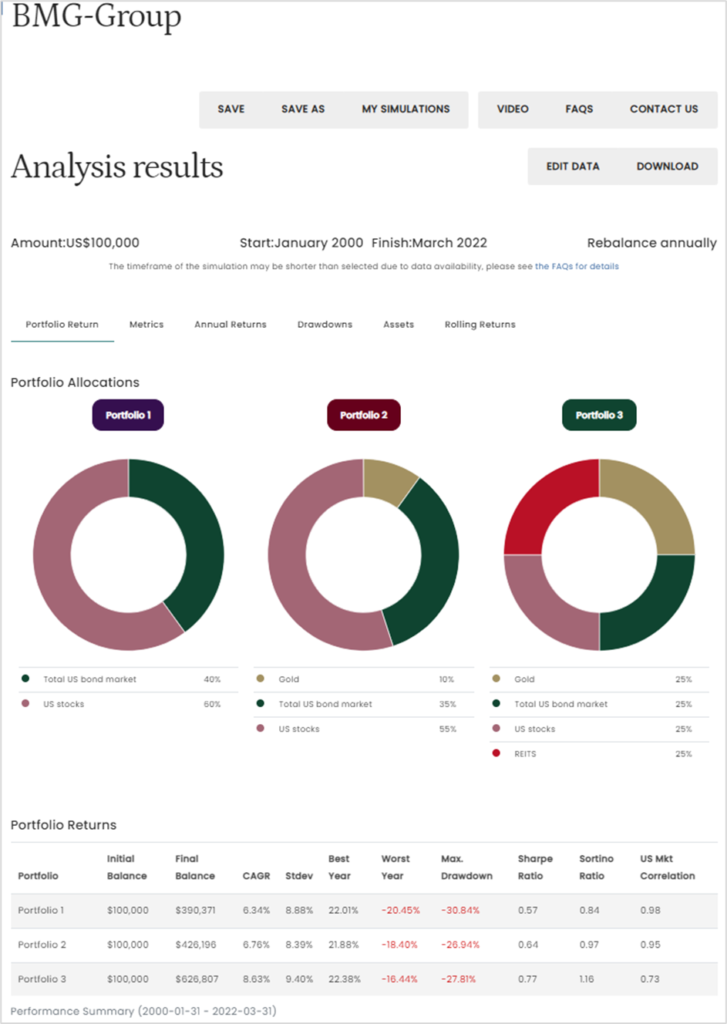
Protecting Portfolios During the Coming Market Crash
As written for Tax and Wealth Management
Today very few portfolios, institutional or personal, have any allocation to gold bullion.
For the last 24 years I have been puzzled by this phenomenon, because any analysis of the data shows that the benefits of gold are obvious. This can be easily verified using the Portfolio Simulator tool at https://www.gold.org/goldhub/portfolio-tools/simulator.
Below is an example for the period from January 2000 to March 2022, comparing the traditional 60/40 portfolio of stocks and bonds to a portfolio with 10% gold, 35% bonds and 55% stocks, and a portfolio divided into four equal parts of stocks, bonds, REITs and gold.
The results from this simulation demonstrate that the addition of gold to a portfolio will:
- Improve returns;
- Minimize maximum drawdowns; and
- Improve Sharpe and Sortino ratios.
However, all investments are based on a currency. Since gold is money and all currencies are a representation of debt, gold should be compared to currencies. The table below shows gold’s performance in all the major currencies. Since 2000, gold has averaged a 10.9% return per annum in all the major currencies.
While portfolio analysis provides a comparison during relatively stable economic conditions, gold tends to shine during periods of economic turbulence. Many experts believe we are heading into a period of stagflation – a deadly combination of increasing inflation and declining GDP. The table below shows the performance of gold during previous stagflationary periods.

Today we are faced with a number of economic challenges that include war, economic sanctions and supply chain imbalances together with a bubble in equities and real estate. As central banks raise interest rates, the bond market will suffer losses and GDP will collapse, resulting in the stock bubble bursting.
It seems that investors are suffering from Normalcy Bias and complacency, since we have experienced the longest-running bull market in stocks and bonds in history, and they fail to recognize that we are in the midst of a paradigm shift. The next 20 years are likely to be the diametric opposite of the last 20 years. The issue of a paradigm shift is set out by Ray Dalio.
Most investors believe that staying invested is the best strategy. Unfortunately, they do not take into consideration how long it takes to break even after a decline. The table below shows the gains necessary to recover from losses.
While institutions have a long investment time horizon, most individual investors do not. After the Wall Street crash of 1929, the market didn’t break even until 1954; the NASDAQ took 15 years to break even after the Tech Crash in 2000; and the Japanese NIKKEI still hasn’t broken even.
Since most of the world’s wealth is held by baby boomers today, many of them will not live long enough to break even if they stay invested during the coming market crash.

In summary, gold will improve portfolio returns as demonstrated by the Portfolio Simulator, but more importantly it will mitigate against losses during a correction, as can be seen from the two charts below.

The best time to buy fire insurance is before you have a fire. Once the fire starts, you won’t be able to buy insurance.








Pingback: We're On The EDGE of a Financial CLIFF | Nick Barisheff - NOBSU